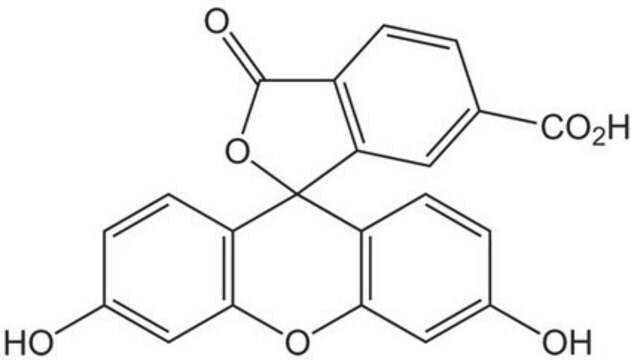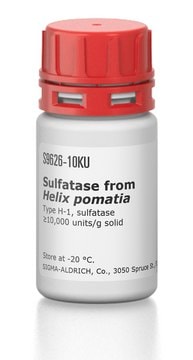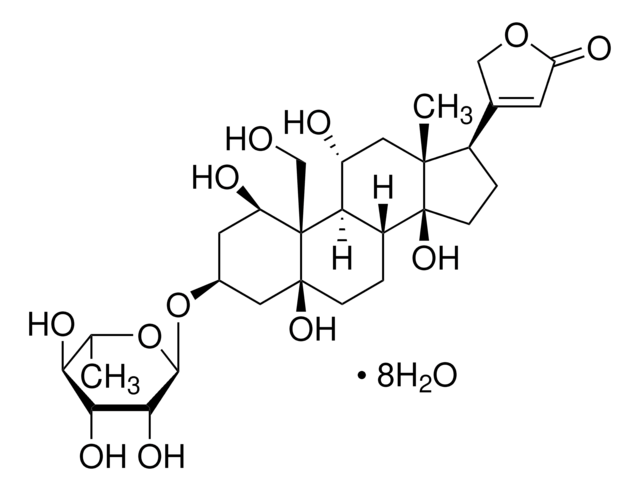Kluczowe dokumenty
T8902
Thiostrepton from Streptomyces azureus
from Streptomyces azureus, ≥90% (HPLC), powder, FoxM1 inhibitor
Synonim(y):
Bryamycyna, NSC 170365, NSC 81722, Tiaktyna, Tiostreptina A
About This Item
Polecane produkty
Nazwa produktu
Thiostrepton from Streptomyces azureus, ≥90% (HPLC)
Próba
≥90% (HPLC)
rozpuszczalność
acetic acid: soluble 25 mg/mL, clear to hazy, yellow to brownish-yellow
spektrum działania antybiotyku
Gram-negative bacteria
Gram-positive bacteria
parasites
Tryb działania
protein synthesis | interferes
temp. przechowywania
−20°C
ciąg SMILES
CCC(C)C1NC2C=Cc3c(cc(nc3C2O)C(=O)OC(C)C4NC(=O)c5csc(n5)C(NC(=O)C6CSC(=N6)C(\NC(=O)C(NC(=O)c7csc(n7)C8(CCC(=NC8c9csc4n9)c%10nc(cs%10)C(=O)NC(=C)C(=O)NC(=C)C(N)=O)NC(=O)C(C)NC(=O)C(=C)NC(=O)C(C)NC1=O)C(C)O)=C\C)C(C)(O)C(C)O)C(C)O
InChI
1S/C72H85N19O18S5/c1-14-26(3)47-63(105)78-30(7)57(99)75-28(5)56(98)76-31(8)58(100)91-72-19-18-40(66-85-43(22-111-66)59(101)77-29(6)55(97)74-27(4)54(73)96)81-52(72)42-21-112-67(83-42)49(34(11)109-69(107)41-20-37(32(9)92)36-16-17-39(79-47)51(95)50(36)80-41)89-60(102)44-24-113-68(86-44)53(71(13,108)35(12)94)90-62(104)45-23-110-65(84-45)38(15-2)82-64(106)48(33(10)93)88-61(103)46-25-114-70(72)87-46/h15-17,20-22,24-26,30-35,39,45,47-49,51-53,79,92-95,108H,4-6,14,18-19,23H2,1-3,7-13H3,(H2,73,96)(H,74,97)(H,75,99)(H,76,98)(H,77,101)(H,78,105)(H,82,106)(H,88,103)(H,89,102)(H,90,104)(H,91,100)/b38-15-
Klucz InChI
NSFFHOGKXHRQEW-BXVAPQLOSA-N
Szukasz podobnych produktów? Odwiedź Przewodnik dotyczący porównywania produktów
Opis ogólny
Zastosowanie
Działania biochem./fizjol.
Uwaga dotycząca przygotowania
Kod klasy składowania
11 - Combustible Solids
Klasa zagrożenia wodnego (WGK)
WGK 3
Temperatura zapłonu (°F)
Not applicable
Temperatura zapłonu (°C)
Not applicable
Środki ochrony indywidualnej
Eyeshields, Gloves, type N95 (US)
Wybierz jedną z najnowszych wersji:
Masz już ten produkt?
Dokumenty związane z niedawno zakupionymi produktami zostały zamieszczone w Bibliotece dokumentów.
Klienci oglądali również te produkty
Nasz zespół naukowców ma doświadczenie we wszystkich obszarach badań, w tym w naukach przyrodniczych, materiałoznawstwie, syntezie chemicznej, chromatografii, analityce i wielu innych dziedzinach.
Skontaktuj się z zespołem ds. pomocy technicznej












